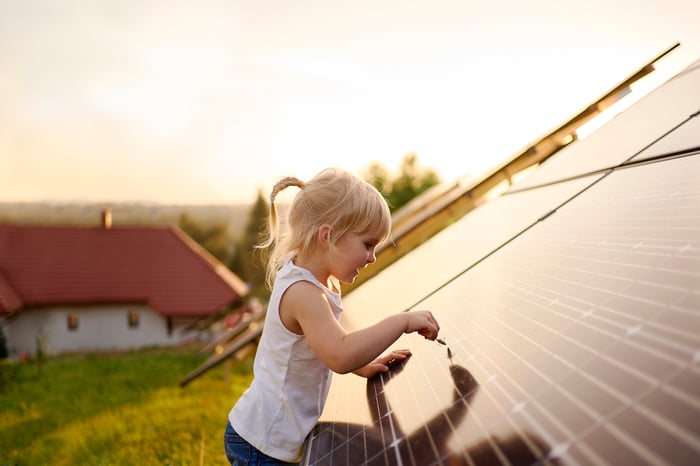The iShares Global Clean Energy ETF has rallied nearly 20% since hitting a low point on Feb. 23. And yet, despite the swift rise, the exchange-traded fund -- a broad proxy for the clean energy sector -- is still down nearly 40% from its January 2021 highs. There's opportunity here for long-term investors looking at names like Brookfield Renewable Corporation (BEPC) -- and some key risks when you dig a little into the sector's dynamics. Here's the good news and the waving red flag you need to watch closely.
Relatively high
Brookfield Renewable Corporation is the sister to Brookfield Renewable Partners (BEP 5.00%), with both managed by Brookfield Asset Management. Brookfield Renewable, which we'll use to refer to both versions of the company since they are roughly identical other than corporate structure, owns a broadly diversified portfolio of clean energy assets.
Roughly half of its cash flow comes from hydroelectric power, a reliable base-load power source (meaning it can meet the minimum level of demand on an electrical grid over a span of time), and a solid foundation for its business. The rest comes from solar (15% of cash flow), wind (22%), and energy transition assets (the remainder). Energy transition is a catchall that includes things like battery storage.

Image source: Getty Images.
In addition to having a broad portfolio of assets under its control, Brookfield Renewable also focuses on broad geographic diversification. North America makes up 64% of cash flows, with South America at 19%, Europe at 15%, and Asia at 2%. So it can put money to work around the world in just about any clean energy technology. That's a huge benefit in the industry, which is likely to see broad demand as the world looks to shift away from carbon fuels. ESG-focused investors should probably view Brookfield Renewable as a one-stop shop for clean energy exposure.
And Brookfield Renewable's plans are huge, which is a big green flag for investors. Right now, it has 21 gigawatts of clean energy capacity up and running across its portfolio. It has plans to build another 61.5 gigawatts of capacity. With triple the existing operational capacity under development, that's a lot of potential growth ahead. Management is targeting capital spending of around $1 billion to $1.2 billion annually for a period of five years. That's a big reason to like the investment opportunity here, with Brookfield Renewable Corporation's stock off around 30% from its early 2021 highs.
The dividend yield is a relatively generous 3%, noting that the S&P 500 Index yields just 1.3% and iShares Global Clean Energy ETF a scant 0.75% or so.
Costs are a problem
So the price pullback and relatively high yield make Brookfield Renewable Corporation attractive for long-term investors, especially since management's stated goal is to increase the dividend annually between 5% and 9%. Add in the long-term shift taking place in the energy sector, and there's very good reason to believe Brookfield Renewable Corporation can achieve its investment goals.
But there's a red flag here that needs to be monitored. Brookfield Renewable isn't the only one looking to take advantage of the broad clean energy shift. There are increasing numbers of players, including the oil majors. The amped-up competition could pose a material problem, noting that in 2021 BP bid roughly 80% more than the average of the next closest bidders for rights to build offshore wind farms in the United Kingdom. If that type of price escalation continues, it will make it harder for the industry to make profitable investments.
Notably, Enbridge, a pipeline company in Canada with a growing clean energy business, is taking a cautious stance for bidding on new projects. It has three material offshore wind farms in development in Europe and doesn't want to overpay for new opportunities. Thus, it is stepping back and working on what it has for now, effectively waiting for more-rational prices before it takes on the risk of a multiyear investment.
It's not that Enbridge won't bid on projects; just that it is unwilling to get into a bidding frenzy. And that's an issue investors need to monitor across the industry, including at Brookfield Renewable Corporation, given that inflation is also increasing the costs of building projects and, thus, reducing return potential.
Nothing to worry about, yet
So far, Brookfield Renewable has proved adept at managing its business and supporting long-term growth. There's material demand for clean energy, and with a sizable backlog of projects, Brookfield Renewable will be there to meet it, which should be good for investors over the long term.
But BP's outsize bid for a clean energy investment opportunity is a clear sign that investors need to be careful here because new entrants might not be acting rationally as they look to secure projects. Add in the generally rising costs today, which means securing and profitably building clean energy projects could become a more material problem.
This isn't a reason to avoid Brookfield Renewable, but it is a red flag to be aware of if you own the stock.





